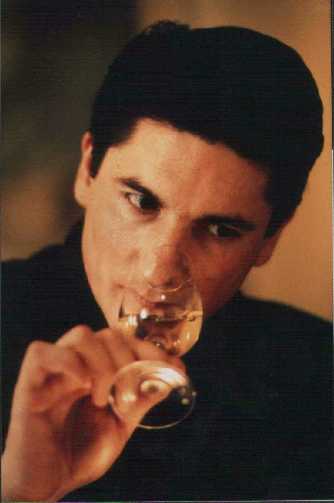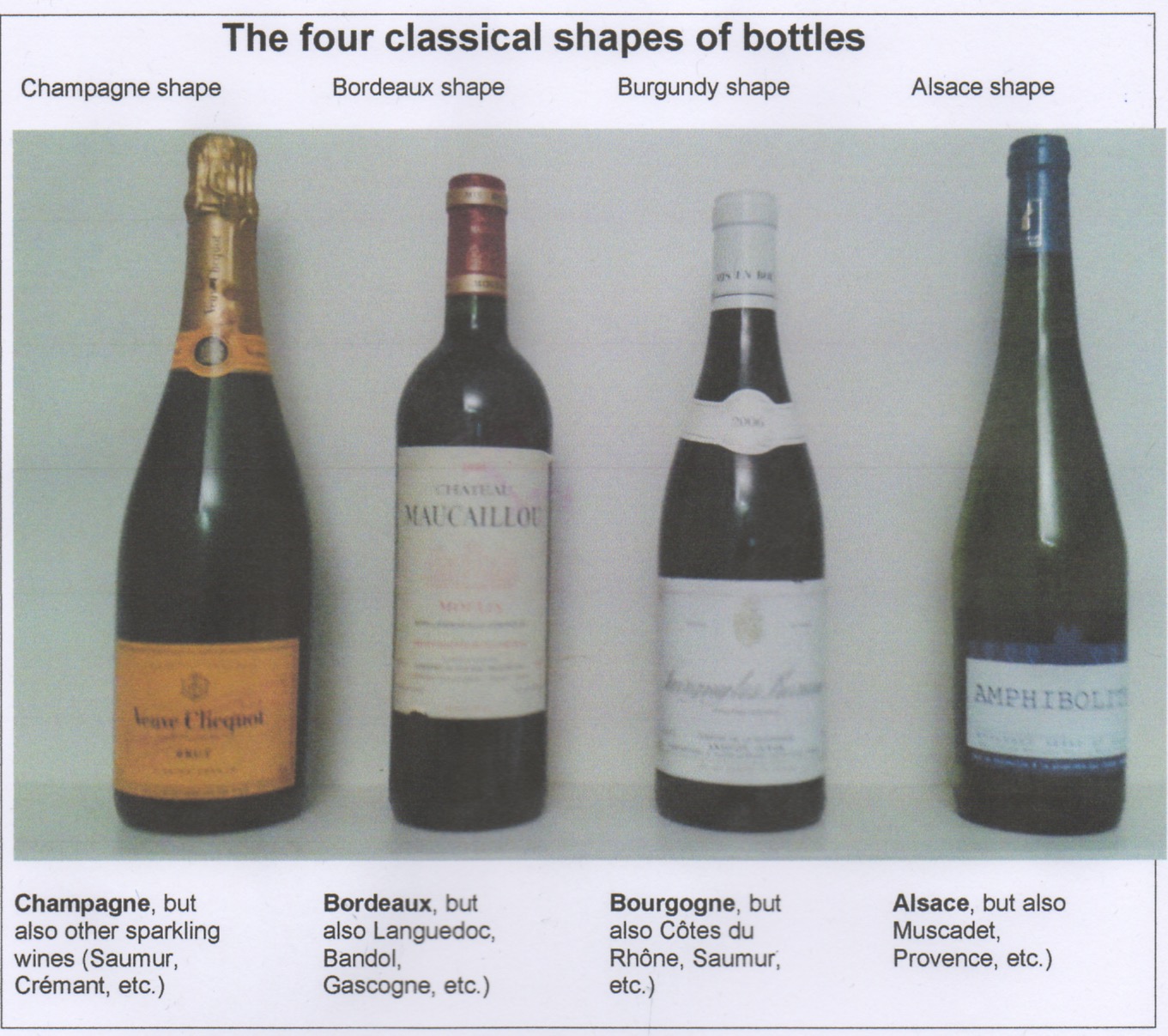|
| There are many different
wines ! |
|
Facts and figures about wine |
-
To taste a wine,
- first look at it (color, transparency,
the light through it,...),
- then smell it (complex or simple,
...),
- then keep it in your mouth (strong,
long, ..),
- then swallow (or spit) it.
|
 |
- Wine is regional and the location of the vineyard (the
"terroir", i.e. the soil) is more important than the
grape !
- Alsace -
white - Gewürztraminer
(sweet), Riesling (dry) - sweet with Munster cheese, dry with
sauerkraut
- Bordeaux
- red or white - Saint-Emilion,
Saint-Julien, Medoc, etc... (red), Sauternes, etc.... (sweet
white) - meat with red, sea food with dry white, foie-gras with
sweet white
- Beaujolais
- red - "Beaujolais
nouveau" which comes out every year in November is not a
good wine : it is only the occasion for a friendly moment, but
the "crus" from Beaujolais have nothing to do with
it and are very good wines : Brouilly, Chiroubles, Fleurie, Morgon,
Moulin-à-Vent, etc...
- Burgundy - red or white - Gevrey-Chambertin, Nuits-Saint-Georges,
etc (red), Chablis, etc..(white) - very small estates
and great wines
- Champagne
- white - Veuve-Cliquot -
this is THE wine for all celebrations
- Jura
- white - Arbois - vin jaune,
a very specific flavor
- Languedoc
- red - Banyuls, Minervois
(red), Muscat (white) - traditionally producing low-quality red
wines, now improving fast
- Loire Valley -
red or white - Bourgueil
(red), Muscadet (white)
- Provence
- rosé or red - Bandol,
Côtes de Provence - the wines for Summer
- Rhône Valley - red - Côtes
du Rhône (red), Tavel (rosé)
- Savoie
- white - Roussette - sometimes
sparkling
- Southwest -
red or white - Cahors - a
great variety of very good wines
- And several less known (Corsica,
Moselle, Basque Country,...)
- Pairing wine with food : no strict rules but :
- generally : red with meat and
white with fish
- no wine on vinegar (drink water
with your salad!)
- if you change wine, go from
light to strong
- more to come...
- Click here for wine
courses and tastings in Paris : it could be a real experience !
DID YOU KNOW
THAT....? Wine is the result of three elements : the "cépage"
(i.e. the variety of grape used : Chardonnay, Merlot, Syrah..)
, the "terroir" (place i.e. type of soil where it grew
: corbières, coteaux-de-l'ardèche, mâcon,...)
and the "producteur" (who did the job : chateau X,...)
; choosing a wine by its cepage only is choosing a wine from
nowhere made by nobody : for some wine experts, especially in
Italy and France, the terroir is the most important factor. In
a restaurant, try ordering a Bordeaux or a Vin de Loire instead
of a Chardonnay or a Merlot!
Is any wine with bubbles a "champagne" ?
Obviously, the answer is NO ! There are other white bubbling wines called "Crémants". A "champagne" can only be produced in a specific region (the Champagne, East of Paris), with a mix of 3 different grapes (Pinot meunier, Pinot noir, Chardonnay). Cremant wines are produced in 8 different regions (the best are from Alsace, Loire Valley or Burgundy). The wine-making process is the same but longer for Champagne (12 months vs. 9 max.). The production of Champagne (300 million bottles/year) is 3 or 4 times bigger but Cremant's is growing faster. Champagne is at least 50% more expensive and on average, Champagne is better, lighter and its taste is more sophisticated. However, a good Cremant is better than an average Champagne.
DID
YOU KNOW THAT.....? Some of the best French wines are sweet
white wines. Americans are not used to this taste and often
expect a sweet white to be mediocre. Don't be prejudiced : it
is not true and sweet whites are among the best French wines.
Try a Sauternes, a Loupiac or a Coteaux-du-Layon with foie-gras
or a blue cheese (Roquefort, Fourme, Bleu d'Auvergne, etc...)
or try one of these gorgeous "Vendanges Tardives" from
Alsace not to mention a Chateau d'Yquem if you can afford it
(it is harvested seed by seed in winter...). But, alas, most
of them are generally rather expensive ... |
|
-
France is a "wine culture"
country, like Italy or Spain (as opposed to "beer culture"
countries) ; people do not drink wine to get drunk but to share
a moment together ; they like to talk about it, discuss its taste,
if it goes well or not with the food, etc... Wine is part of the French identity and is not considered like just an alcoholic beverage (it is not exceptional to hear a sentence like "I don't touch alcohol : I drink only wine"!).
| "Wine is Food" : a typical example of the "educational" posters you could find everywhere (including schools) until the 1950s and giving the dietetic equivalent of one bottle of wine in milk, bread, meat, eggs, etc. Its conclusion : "wine is food : drink wine" |
 |
-
In France you do not call (and
order) a wine by its grape (Chardonnay, Merlot, Cabernet, etc...)
but by its origin (Saint-Emilion, Pommard, Bandol, ...).
The shape of the bottle is specific to each region : narrow
for Alsace, cylindrical for Bordeaux, plump for Burgundy, etc...
-
Only the wine coming from the region of Champagne can
be called "Champagne" but there are several other (very
good) sparkling white wines : Vouvray, Crémant d'Alsace, Clairette,
Blanquette, ...
-
Basic glossary :
- AOC (Appelation d'Origine Contrôlée)
: guarantees origine, grape variety and production methods. AOC is a very strong legal protection
for the consumer : it guaranties that the product (wine but also any other food like cheese or vegetable protected by an AOC label) comes from a specific region and has been elaborated according to a specific standard. Practically speaking, it means "good" !
- Vin de Table : resulting from
a blend of grapes from different regions ; never very good
- VDQS (Vin Délimité
de Qualité Supérieure) : quality classification
of simple country wines
-
The French consumption
is very high : 53 liters/year (source : FAO-2002) compared to
8 for USA and 17 for UK. See detailed comparative figures
and, although challenged by new producers, France as well as
and Italy keep their status of leaders : see figures.
Concerning the consumption in France, the proportion is (roughly) : Red = 50%, Rose=30% (and growing), White=20%.
-
Read about cheese
-
TIP : If you want to buy
wine in Paris and don't know much about it, go to a chain
shop "Nicolas" : they have reasonably good wines and
are generally helpful
- Contrary to what one could think,
- a Rosé
wine is NOT the mix of a red and a white wine ! It is made
of red grapes fermented in such a way that the color is light
and sometimes very light. Rosé wines represent a growing proportion of French wines (France is the largest producer in the world)
and they are getting better and better, just when the European
administration was considering (in 2009) to legalize the name
"rosé" for the mix of red and white wines !
Another French fight against beer-drinking countries and apparently it was won!
Main Rose regions are : Provence, Anjou and Bordeaux.
- a sweet White wine is not a cheap wine : see below
- The Wood-Shaving-War
: to taste good and age
well, wine requires tannin, which is traditionally provided by
oak barrels. In many countries, typically in the USA, wine in
stored in metallic barrels and wood shavings are added. This
is strictly prohibited by French regulation. Again, France has
to fight against the European
administration which, under the pressure of countries which
do not produce any wine, want to make it legal. It is feared
that this war will be lost. See also the Raw-Milk-War
and the Chocolate War
and other European controversies.
- More to come...
DID
YOU KNOW THAT.....? France produces over 200 million bottles of cognac a year. 98% (!) are exported (USA, China, Hong-Kong, Singapour, etc.) |
| Wine etiquette |
|
Bottle shapes |
-
Pouring wine : Do not fill up a glass to the top
: two thirds is a maximum. The French respect wine : paper glasses,
ice cubes, etc.. are definite NONOs! And do not serve yourself
: wait for your host to do it !
- Do not drink it too fast : first smell it quietly.
-
It is best NOT to bring wine
as a gift, except for close friends or informal dinner parties
: a good host has tried to match the wines with the food and
an unexpected wine could jeopardize it!
-
If you clink glasses, don't touch the other glasses (especially if your host wants to honor you by using precious cristal glasses...) : just lift your glass and smile!
-
More on wine etiquette on the
page about "French Fried : the Culinary
Capers of an American in Paris"
DID YOU THAT....?
On average, the French drink 6,6 times more wine than
Americans, eat 60% more cheese and drink 3 times less beer !
(see international comparisons) but, globally, the consumption of alcohol in France is significantly smaller than in many of the other European countries (see numbers). |
|

Shape and capacity of bottles : The capacity of the bottle varies, with different names, as a proportion of the Bordeaux bottle (75 centilitres, i.e. 1.58 pints or 25.5 ounces) : fillette = 0.5 Bordeaux bottle, magnum = 2 bottles, jeroboam = 4 bottles, mathusalem = 8 bottles and a few others, less known, the biggest being the nabuchodonosor (=20 bottles) which is only for Champagne. |
| To related pages : intercultural differences, French attitudes, tips
on food, cheese, etc... |
|
To table
of contents
To top of the page
Back to home
page
|
Harriet Welty
Rochefort writes articles and books about France and the French.
Order her books :
- "Joie de Vivre", Secrets of Wining, Dining and Romancing like the French, St.Martin's Press, New York, 2012
- "French Toast, An American in Paris
Celebrates The Maddening Mysteries of the French", St.Martin's Press,
New York, 1999
- "French Fried, The Culinary Capers
of An American in Paris", St.Martin's Press, New York, 2001
More on Harriet's
books
(excerpts, upcoming events, testimonials, etc..)
|
| To
email
me |
If you like
this site, please bookmark it or create a link! |
|